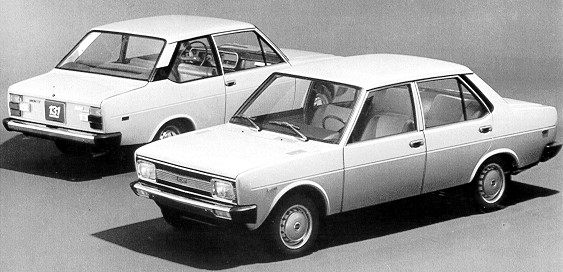By Simon Ryle
As the production of the 131 ‘mirafiori’ spanned more than a decade, with two ‘facelifts’ and three different body styles, (two door saloon, four door saloon and five door estate), not to mention the various engine types and sizes, I have decided to write its history in three parts. They will deal with each of the models running from 1974 to ‘78, ‘78 to ‘82, and ‘82 to ‘85.
Much has been written of Fiat’s sporting heritage and achievements, and links with such companies as Abarth. Whilst I recognise these I shall not be repeating the words of others in the telling of their story, only to outline the technical specs and differences to the standard production models.
The 131 ‘mirafiori’ was produced in several countries, by different manufacturers using different designations, most notably in Spain and Turkey. Within this text I shall detail only the vehicle as manufactured in Italy by Fiat Auto SpA.
Introduction
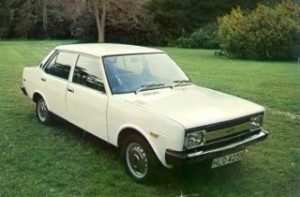 The 131 ‘mirafiori’ was introduced in Italy in the Autumn of 1974, to replace the 124 which had entered production in 1966, and was generally available across Europe from early 1975.
The 131 ‘mirafiori’ was introduced in Italy in the Autumn of 1974, to replace the 124 which had entered production in 1966, and was generally available across Europe from early 1975.
This was a difficult time for the car producers of the World, as we were entering the first of the many Petrol Crises of the period, when leaded 4 star was approaching £1 Sterling per GALLON! Therefore Fiat’s new car had to be spacious and economical without losing performance.
The ‘standard’ 124 cars had been available with 1197cc over head valve (ohv) engines developing 65 bhp, whilst the ‘Special’ was fitted with a 1438cc ohv engine developing 75 bhp. The first generation of engines installed in the 131 were derived from these, albeit of larger capacities.
Why 131 ‘mirafiori’ ?
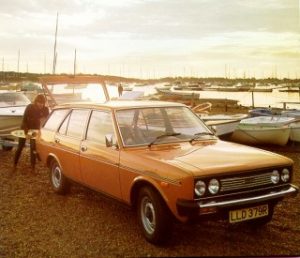 This is a fairly simple question to answer.
This is a fairly simple question to answer.
Each of the new projects passing through Fiat’s design office during the late ‘60’s were, and still are, given a designation number so as to identify it from the others running in parallel. These designations always related to the prefix on the chassis numbers and usually to the order in which they entered production. However as if to be the exception to the rule, the 131 was launched some two years after its bigger sister, the 132.
Earlier Fiats were often known by their engine sizes, for example 500, 600, 850, etc., but as cars of similar engine capacities were being produced (i.e. the 1100 of the 50’s and the 1100 128), this could have lead to confusion.
The ‘mirafiori’ name came from the suburb of Turin in which the model was to be manufactured. Fiat had set up a manufacturing plant here early in the Company’s life, and some great vehicles have been assembled here, including the Topolino, the 1100 of the 1920’s, the 850, and the Uno. I believe that the Punto is currently produced here.
The use of a name instead of numbers was to be Fiats future. Indeed the next new model from Fiat was the Ritmo/Strada of 1979, which, had numbers still been the order of the day, would have been the Fiat 138!
The 131 ‘mirafiori’ ‘Mark 1’ (1974 to 1978)
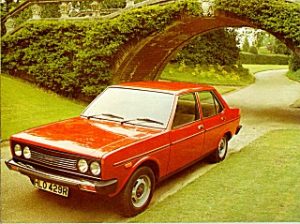 It is fairly easy to identify a Mark 1 from other 131s. From the front it has either two small rectangular headlights each mounted in a chrome surround (Standard trim), or four round headlights all of the same size, arranged in groups of two (Special trim). The bonnet has an indentation formed in it, approximately two inches from either edge, running front to back, as does the boot lid. The rear lights are a sideways ‘T’ arrangement, and both bumpers are chrome plated, the Special having rubber inserts.
It is fairly easy to identify a Mark 1 from other 131s. From the front it has either two small rectangular headlights each mounted in a chrome surround (Standard trim), or four round headlights all of the same size, arranged in groups of two (Special trim). The bonnet has an indentation formed in it, approximately two inches from either edge, running front to back, as does the boot lid. The rear lights are a sideways ‘T’ arrangement, and both bumpers are chrome plated, the Special having rubber inserts.
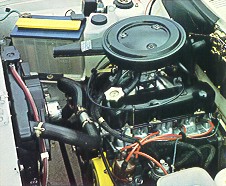 The early 131s were available with either 1297cc or 1585cc ohv powerplants developing 65 bhp and 75 bhp respectively. It is interesting to note that there was a ‘low octane’ version of the 1297cc unit available for the German market, having a lower compression ratio (7.8 to 1 compared with 9.2 to 1 for other markets), and developing only 55 bhp! Not alot of power to pull a fully laden estate car weighing up to 1460kg (only 37.7bhp per tonne!).
The early 131s were available with either 1297cc or 1585cc ohv powerplants developing 65 bhp and 75 bhp respectively. It is interesting to note that there was a ‘low octane’ version of the 1297cc unit available for the German market, having a lower compression ratio (7.8 to 1 compared with 9.2 to 1 for other markets), and developing only 55 bhp! Not alot of power to pull a fully laden estate car weighing up to 1460kg (only 37.7bhp per tonne!).
Technically the car was similar to the 124 in as much as it was front engine, rear wheel drive, and was of the ‘three box’ body design. However where the 124 had discs all round, the 131 had rear drums. The 131 also had MacPherson front suspension and rack-and-pinion steering, when the 124 had worm-and-roller. Further, the 131 had a ‘live’ rear axle, located by four cushioned trailing arms and a Panhard rod.
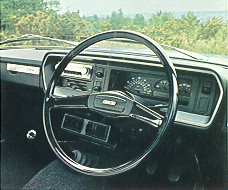 The ‘1300’ was available as a 2 door, 4 door or 5 door estate, Standard and Special trim levels, with the estate being in Standard form only. The ‘1600’ was available as a 2 door, 4 door or estate , Standard and Special trim levels, and could be ordered with optional 5 speed or automatic gearbox. The 1600 Special could also be fitted with optional air conditioning.
The ‘1300’ was available as a 2 door, 4 door or 5 door estate, Standard and Special trim levels, with the estate being in Standard form only. The ‘1600’ was available as a 2 door, 4 door or estate , Standard and Special trim levels, and could be ordered with optional 5 speed or automatic gearbox. The 1600 Special could also be fitted with optional air conditioning.
Another interesting point is that the estate car was 1/2 an inch shorter than the saloon in sales literature of the day, but Fiat’s own Workshop Manual has them both the same length, albeit the Special is longer than the Standard model due to the rubber bumper inserts.
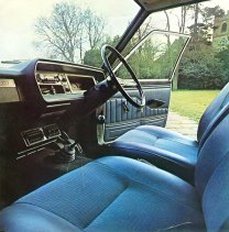 Other options available on the earlier 131 range included metallic paint, tinted glass, heated rear window, radio, steering lock ignition switch, vinyl roof (very ‘70s!) and seat belts! Most of these considered ‘essential’ to modern motoring, some of them being law! The 1600 Special saloons were also available with a limited-slip differential, which I can only assume was thought necessary in icy or muddy conditions, or where tyres with no tread were fitted!
Other options available on the earlier 131 range included metallic paint, tinted glass, heated rear window, radio, steering lock ignition switch, vinyl roof (very ‘70s!) and seat belts! Most of these considered ‘essential’ to modern motoring, some of them being law! The 1600 Special saloons were also available with a limited-slip differential, which I can only assume was thought necessary in icy or muddy conditions, or where tyres with no tread were fitted!
Not all of the models and options mentioned above were available in Great Britain in early 1975, however by November of that year the heated rear window was standard on all models!
Performance was not considered in terms of 0 to 60 times in 1975, and therefore there are no figures (that I know of) currently available for the ‘Mark 1’ 131. However in November 1978, when the ‘Mark 2’ 131 (CL) saloon was launched, basically the same car (same 1300 and 1600 ohv engines) was said to reach 60mph in ‘less than 16 seconds’ and ‘under 13 seconds’ respectively.
As for fuel economy, again I can only quote from the data available for the 1978 CL saloon. The 1300 had a combined economy of 30.7mpg, whereas the 1600 5 speed manual was 32.7mpg! Perhaps this explains why so few 1300s were sold.
In February 1977 the range was ‘updated’. There were changes to the trim, both in terms of fabric type and colour, and the ‘1600’ Special received front head rests, a rev counter and a 5 speed manual gearbox as standard equipment.
The ‘mirafiori’ Racer
 In the mid 1970s Fiat were extremely keen to promote the sporting nature of their otherwise run-of-the-mill cars. To do this they outsourced expertise in rallying by procuring the services of the Abarth Company in Turin.
In the mid 1970s Fiat were extremely keen to promote the sporting nature of their otherwise run-of-the-mill cars. To do this they outsourced expertise in rallying by procuring the services of the Abarth Company in Turin.
Abarth had already had great success with Fiat (124 Spider) and were looking to strengthen the relationship. Of course it must be mentioned that by this time Abarth were already part of the Fiat Empire, and it may well be considered ‘jobs for the boys’, but in any case this is now all part of their histories.
Fiat needed to continue their good fortune in rallying, but as the 124 was being replaced by a somewhat less sporting model, Fiat saw the ideal marketing opportunity. They asked Bertone to spruce up the bodywork and Abarth to breathe on the mechanicals.
Abarth took a standard 2 door saloon and threw away the mechanicals. The pushrod engine was replaced with a 1995cc 16 valve twin cam unit, developing up to 210bhp in carburettored form. The live rear axle was replaced by one with fully independent suspension. The front suspension was uprated, and the gearbox linkage modified.
Bertone took away the doors, boot lid and bonnet and replaced them with fibreglass or aluminium. The glass was replaced with perspex to save further weight. Large extended arches were bolted on to accommodate the 10 x 15 (front) and 11 x 15 (rear) Cromodoras. The interior was stripped, and in an effort to more evenly distribute the weight of the occupants, the co-driver was positioned centrally in the back seat over the axle!
My personnel experience of the Mark 1
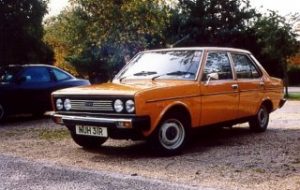 My current 131 is a ‘Burnt Orange’ 4 door 1600 Special, which I have owned for about a year. Registered 1st August 1976, it was purchased new for the list price of £1,879 plus £156.58 car tax, and a £45 delivery charge. The optional 5 speed gearbox was £80 plus car tax, with £7.50 for number plates, and £20 for front seat belts. All plus 8% VAT of course. Road tax for a year (£40) and a full tank of petrol (£14.50) bringing the total ‘on the road’ price to £2,425.99.
My current 131 is a ‘Burnt Orange’ 4 door 1600 Special, which I have owned for about a year. Registered 1st August 1976, it was purchased new for the list price of £1,879 plus £156.58 car tax, and a £45 delivery charge. The optional 5 speed gearbox was £80 plus car tax, with £7.50 for number plates, and £20 for front seat belts. All plus 8% VAT of course. Road tax for a year (£40) and a full tank of petrol (£14.50) bringing the total ‘on the road’ price to £2,425.99.
I am extremely lucky as my Special is virtually unmarked, having been garaged all of its life and covering only 13,500 miles, but most were scrapped early as a result of rust and their poor market values.
Soon after taking over ownership of the Special, the head gasket gave way. The cause of this turned out to be a sheared off head bolt, that I could only assume had been like it from the factory! Anyway it was a relatively simple repair, without the need to reset the valve timing.
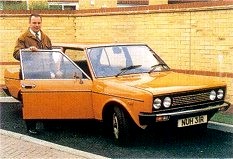 The only other work to be carried out has been routine (every 12 months) servicing, and the replacement of a steering rack gaiter and trackrod end. I’ve also had to fit a centre section of exhaust, and for todays motorway driving, I also fitted a new set of tyres, although the originals (factory fitted) still had plenty of tread!
The only other work to be carried out has been routine (every 12 months) servicing, and the replacement of a steering rack gaiter and trackrod end. I’ve also had to fit a centre section of exhaust, and for todays motorway driving, I also fitted a new set of tyres, although the originals (factory fitted) still had plenty of tread!
I have owned 131s virtually all of my driving life, and I love them! They may be quirky, but show me an Italian car that isn’t.
What to look for if buying a Mark 1
 The biggest ‘killer’ of the 1970’s Fiat is rust. There’s no denying it. The 131 is no exception and will rust anywhere! Unfortunately few 131 survive, the majority being Sports (Mk 2) and 2000TC Supers (Mk 3), with a tiny number being Mark 1s. Most have succumbed to the ravages of British winters, the freeze-thaw effect, salted and gritted roads, coupled with poor quality steel and almost non-existent rust protection from the factory.
The biggest ‘killer’ of the 1970’s Fiat is rust. There’s no denying it. The 131 is no exception and will rust anywhere! Unfortunately few 131 survive, the majority being Sports (Mk 2) and 2000TC Supers (Mk 3), with a tiny number being Mark 1s. Most have succumbed to the ravages of British winters, the freeze-thaw effect, salted and gritted roads, coupled with poor quality steel and almost non-existent rust protection from the factory.
131s are of the monocoque construction, and as such they have no separate chassis. The strength is in the pillars and the floor, and they are prone to rust. Particular attention must be paid to the underside of the car. Check carefully sills, outriggers, jacking points, the bottom of A and B pillars and rear wheel arches. Front arches were fitted with plastic liners, so check to see whether they are still in place. If they are missing this could indicate that the wings have been replaced.
Doors are a weak point, as they are designed to allow water to flow through them! If the drain holes are blocked they will disappear from the bottom up. Boot lids and bonnets will corrode along their edges, and folded seams can unfold! Particularly check where the bonnet rubber ‘stops’ rest on the top of the wing/scuttle as water collects here, and it is common to see the road through the metalwork!
I have seen panels rust in the middle for no apparent reason! Check all panels and channels, and pay attention to the screen surround, front and rear, as these too can rot. A particularly prone area is around the fuel filler cap. Water collects here every time it rains or a car is washed. Fiat’s solution was to insert a plastic liner, that only helped trap water underneath, as there was no drain!
The interiors are generally pretty tough, however the seats often wear thin and can become saggy if the car has covered high mileage. Generally though seats and door cards can be interchanged between 131s with the same number of doors.
Mechanicals on the Mark 1 are fairly bomb proof. Even if the body is tired, the chances are the engine and drive train will be serviceable. The engine, gearbox and rear axle are all prone to leaks, and if there aren’t any you probably need to ask why!
Summary
To my mind the early 131 remains a good prospect for the enthusiast DIY restorer. Remember that the newest Mark 1 is now over 22 years old, and is entitled to show signs of age. Overall though the early Mark 1 is a joy to own, with all the systems being simple and easy to work on, particularly by modern standards.
The 4 door and estates are the most practical, with many a 2 door machine being used as a donor car for the more desireable Sport, which is a shame.
I still get a buzz out of driving mine, and it’ll be in the family for a while yet!

![Fiat Motor Club [GB]](https://fiatmotorclubgb1.netfirms.com/wp-content/uploads/2017/11/Website-Header-v3.jpg)
